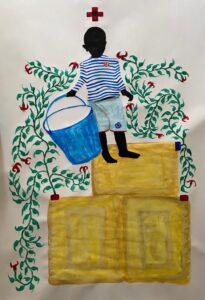
SAÏDOU DICKO
About:
Saïdou Dicko was born in Burkina Faso in 1979, self-taught visual artist (photographer, videographer, installer and painter). He lives and works in Paris.
Since his childhood he has been fascinated by shadows, and when he discovered shadows through the magic of images, it became a passion and a calling. Now shadows are present in all of his work.
Through painting, photography, video or installations, Dicko transforms the representation of forms giving life to visual phenomena, to physical and psychological events of light, uniting the two extreme values that are at the heart of black and white contrast. He finds pleasure in bringing together the opposites to talk to us about equality, union, maternal love, freedom, humanity …
Since then, his work has been presented at many international events (biennials, international fairs, exhibitions).
His works received several prizes : Prix Blachère in 2006 in Dakar Biennal, prize of the francophonie at African photography encounter of Bamako in 2007, Fondation Thamgidi prize in 2008 in Dakar and the Off prize of European Union.
In 2012, he co-founded the collective “Rendez-Vous of Artists” which is a nomad platform where artists of all kinds: curators, gallerists, art lovers, cultural journalists, etc.. exchange. These exchanges sometimes lead to exhibition projects.
Since 2013, he also works as a curator (3th International Biennial of Casablanca) and scenographer mostly in Morocco with Arkane Africa.
His artistic work continues to evolve thanks to his travels, his experience, his various inspirations and always his quest for a better world.
His new series “The Shadowed People” is a reflection of all these years of work and research. He unveils himself to present us more and more poetic and poignant works.
“Peuhl culture is part of my identity. Everything I learned, as socially as artistically speaking, comes from this culture. My childhood imaginary, directly rooted in Peuhl tradition, is the genesis of my work and the mother ship of my inspiration. For one moment in my life, my family and I were nomads.
When I was a boy, I used to keep goats, sheep, and cows. As children are taller than goats, I was driven to merely draw goats. As we are above them, we can have a more detailed look to draw them. At the opposite, cows are way too high to be completely perceived by a child. Animals are extremely important in Peulh culture. They are celebrated and healed. People are fed with their milk and meat, even if the meat is mainly eaten during celebrations.”
“Some of my artworks feature secondary raw material. Ecology is particularly important in my work. In my country, we use to say “nature is aging” as we would say for men. Nature melts, dries, and sometimes resources are not sufficient.”
